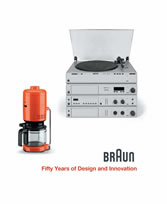Suchen und Finden
Service
BRAUN – Fifty Years of Design and Innovation
Bernd Polster
Verlag Edition Axel Menges, 2001
ISBN 9783936681352 , 504 Seiten
Format PDF, OL
Kopierschutz DRM
Braun Design History (p. 29-30)
The rise: 1921–1951
Braun products have been shown more frequently at exhibitions than those of any other comparable company. Some people find that they reflect basic human values such as authenticity and integrity. For others, they are the very incarnation of German perfectionism. Braun is not merely a trademark, it stands for an all-encompassing concept. For the last five decades, this concept has spawned innovative products with an unprecedented regularity that begs to be explained – especially as the era spanned by the history of Braun design is not exactly one characterized by continuity. The second half of the 20th century witnessed a dramatic change in living conditions. Prosperity and greater ease entered our daily lives, but also widespread disorientation and alienation. It is to the credit of those who set the Braun design project in motion that they were able to counteract this feeling of alienation – which manifested itself to them not least in poorly designed objects of daily use – with a vision of design reform. There had already been attempts made along these lines.
What was new was that a commercial enterprise spearheaded the movement. Also new was the systematic approach, the application of design principles to modern products and the innovative dynamic thus triggered. Finally, the considerable commercial success this design project enjoyed was likewise a revelation. All of this led the company to establish a design department that was not merely an appendage, but rather an active decision-maker in the development of products from the initial idea to realization. This is how Braun and design became synonymous.
At the beginning of the 1950s there was not yet any sign of this striking trajectory. When Max Braun passed away unexpectedly in 1951, it appeared to be not only a personal tragedy but a great misfortune for the business as well. The company founder, who had lived for a long time in Berlin, rising through the ranks from skilled worker to factory owner, was a powerful, charismatic figure and seemed to be virtually irreplaceable. He embodied a type that was not so rare in the Germany of those days – the inventor / entrepreneur. He was a self-made man who, back in the days of the Kaiser, had acquired his electrical engineering and English skills at night school – a restless man of robust stature and Prussian rigour. The company’s ascent was founded on his practical product ideas, including an easy-to-handle belt fastener, a mechanical flashlight and, what would later prove a worldwide success, the electric razor with shear blade.
The company’s roots go back to the early 1920s, when radios were still, as a rule, homemade and Max Braun finally succeeded in gaining a foothold in the radio industry that was only just emerging at the time, by offering detectors he had developed himself, and other components. Born in East Prussia, he married a woman from Hesse and relocated to that region, first to Wiesbaden and later to Frankfurt. The couple soon had two sons, Erwin and Artur. Women were now cutting off their old-fashioned braids and sporting chic pageboys instead. In the second half of the 1920s, with the economic engine gradually gearing up, the American Charleston rhythm started bringing the record and radio industries up to speed.



